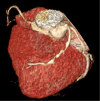The association of coronary non-calcified plaque loading based on coronary computed tomography angiogram and adverse cardiovascular events in patients with unstable coronary heart disease-a retrospective cohort study
- PMID: 36245619
- PMCID: PMC9562535
- DOI: 10.21037/jtd-22-933
The association of coronary non-calcified plaque loading based on coronary computed tomography angiogram and adverse cardiovascular events in patients with unstable coronary heart disease-a retrospective cohort study
Abstract
Background: Coronary computed tomography angiogram (CCTA) has the characteristics of non-invasive, high resolution, and can accurately determine the characteristics of tubular wall plaques. The non-calcified plaque loading of the coronary arteries is unstable and prone to shedding, leading to adverse cardiovascular events. However, few studies focused on the predictive value of non-calcified plaque loading for adverse cardiovascular events in patients with unstable coronary heart disease (CHD). The present study was conducted to investigate the association of coronary non-calcified plaque loading based on CCTA and adverse cardiovascular events in patients with unstable CHD.
Methods: A total of 206 patients with unstable CHD were collected and followed up for 1 year. The patients were divided into an observation group (n=56) and a control group (n=150) according to whether adverse cardiovascular events occurred or not. We analyzed the predictive value of coronary artery non-calcified plaque loading for adverse cardiovascular events in unstable CHD using receiver operating characteristic and multivariate logistics regression analysis.
Results: Compared with the control group, the non-calcified plaque volume in the observation group was increased (160.10±44.02 vs. 128.06±42.22 mm3, P=0.000); non-calcified plaque loading increased (26.93%±7.98% vs. 21.46%±7.62%, P=0.000); carotid intima-media thickness increased (1.49±0.17 vs. 1.40%±0.18 mm, P=0.001); and left ventricular ejection fraction (LVEF) was significantly reduced (53.28%±7.39% vs. 58.02%±7.91%, P=0.000). Non-calcified plaque volume and non-calcified plaque loading have certain diagnostic value for recurrence of adverse cardiovascular events within 1 year (P<0.05). A non-calcified plaque volume >145.58 mm3 is a risk factor for recurrence of adverse cardiovascular events (P<0.05).
Conclusions: Increased non-calcified plaque volume in patients with unstable CHD is associated with the development of adverse cardiovascular events in patients with unstable CHD.
Keywords: Unstable coronary heart disease (unstable CHD); coronary computed tomography angiography; non-calcified plaque loading; predictive value.
2022 Journal of Thoracic Disease. All rights reserved.
Conflict of interest statement
Conflicts of Interest: All authors have completed the ICMJE uniform disclosure form (available at https://jtd.amegroups.com/article/view/10.21037/jtd-22-933/coif). The authors have no conflicts of interest to declare.
Figures


References
-
- Infante T, Cavaliere C, Punzo B, et al. Radiogenomics and Artificial Intelligence Approaches Applied to Cardiac Computed Tomography Angiography and Cardiac Magnetic Resonance for Precision Medicine in Coronary Heart Disease: A Systematic Review. Circ Cardiovasc Imaging 2021;14:1133-46. 10.1161/CIRCIMAGING.121.013025 - DOI - PubMed
-
- Patel VI, Roy SK, Budoff MJ. Coronary Computed Tomography Angiography (CCTA) vs Functional Imaging in the Evaluation of Stable Ischemic Heart Disease. J Invasive Cardiol 2021;33:E349-54. - PubMed
LinkOut - more resources
Full Text Sources
